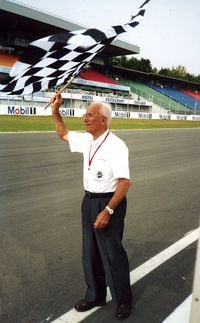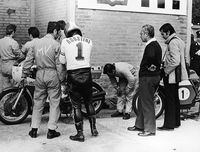Little more than two months after celebrating his 90th birthday, one of the most illustrious figures in Italy's rich panoply of motorcycle history has passed away, with the death on December 2 in his home at Samarate northwest of Milan of former MV Agusta team manager turned motorcycle manufacturer, Arturo Magni.
Even if he hadn't started building the streetbikes bearing his name almost 40 years ago, Magni would still have been a legend in his lifetime, a backroom boy made famous by the serial success of the MV Agusta Grand Prix team whose leader he was. As supervisor of the small band of men responsible for Count Domenico Agusta’s two-wheeled Ferraris during their 26-year dominance of Grand Prix motorcycle racing, Arturo Magni was the driving force behind the copious World Championships won by such acclaimed racing legends as John Surtees, Mike Hailwood, Giacomo Agostini and Phil Read.
During Magni’s reign as team manager charged with overseeing the entire operation of MV Agusta’s Reparto Corse, the red and silver ‘fire engines’ dominated the prestigious 500cc class for more than a quarter of a century, even in the face of Honda’s challenge in the 1960s - until the FIM’s short-sighted noise regulations brought that era to a close. And when that happened, Arturo Magni took on another challenge, in becoming a motorcycle manufacturer in his own right.
Arturo Magni was born on September 24, 1925 in Arcore, a small market town close to the Monza Autodromo which until 1993 was the home of Italy’s most historic motorcycle manufacturer, Gilera. But bikes were originally of little interest to Arturo, who as a boy was more interested in building model aircraft, then later designing and constructing the full-size gliders with which he became a star at pre-WW2 air shows. In 1942, he won the Italian powerless endurance title in his own self-made glider with a three-meter wingspan, and one of his gliding team colleagues was Ferruccio Gilera, son of company boss Giuseppe, who, after WW2 ended, found Magni a job working in the Gilera motorcycle factory in Arcore.
When Ferruccio’s dad Giuseppe Gilera decided in 1947 to re-enter 500cc Grand Prix racing, Magni was chosen to help develop Gilera designer Pietro Remor's all-new four-cylinder racebike, which would win six 500cc world titles during 1950-57 in the hands of Duke, Masetti and Liberati. But in 1950, Count Domenico Agusta hired Remor away from Gilera to design the first four-cylinder MV Agusta GP racer - and Magni went with him as the fledgling MV Agusta team’s chief mechanic. John Surtees won MV Agusta’s inaugural 500cc World title in 1956, and with the retirement of both Gilera and Moto Guzzi from racing, 1958 saw the start of an unparalleled 17 years of successive World title victories in the 500cc class by the MV Agusta team under Arturo Magni’s direction. In 1959 he was appointed to head up the entire MV racing department under Count Domenico Agusta's guidance - leading Arturo to be christened Comandante, or commander by his teammates and the Italian press.
Magni pursued that role until MV Agusta retired from GP racing at the end of 1976, after registering no less than 270 Grand Prix race victories en route to 75 World Championships, including 37 Rider’s titles won by Sandford, Provini, Ubbiali, Surtees, Hocking, Hailwood, Agostini and Read. The MV Agusta team also won 28 Italian National championship titles, and no less than 35 Isle of Man TT race victories. During all this time, Magni was in sole charge of MV's racing department - Count Agusta paid the bills, but Magni ran the race team and supervised the entire technical operation, including the development of legendary designs like the title-winning triples, the later fours, the six-cylinder prototypes, and the abortive, uncompleted Boxer flat-four.
When MV pulled out of racing after 1976, Arturo founded his own company, EPM/Elaborazioni Preparazioni Magni, in nearby Samarate, northwest of Milan, together with his two sons, Carlo and Giovanni. To begin with, they concentrated on producing special parts for the shaft-drive four-cylinder MV Agusta 750S street bikes, including chain-drive conversions and big bore kits to bump engine capacity up to 861cc. But EPM was also one of the world's first suppliers of aftermarket cast aluminium wheels, and in due course eldest son Carlo took over this side of the business, leaving his dad Arturo and younger brother Giovanni to concentrate on the bike-building side under the Moto Magni name (www.magni.it).
Inevitably, the first Magni frames built from 1977 onwards housed the four-cylinder motors powering the MV Agusta 750 Sport streetbike manufactured close by at Gallarate, for which EPM was commissioned to build the chassis. But the end of MV Agusta motorcycle production in 1980 forced Moto Magni to find another source for engines, so around 300 Magni FZ900 Hondas were built in two years of production in 1980/81, followed by 150 examples of the BMW Boxer-based cafe racer which appeared in 1982. But this bike's debut coincided with the launch of the four-cylinder K100 ‘Flying Brick’ range, and the consequent (temporary) suspension of Boxer production, so Magni next created an all-Italian motorcycle. The first Magni Guzzi Le Mans appeared in 1985, and over 900 Guzzi-engined Magni V-twin motorcycles were constructed thereafter, carrying the company’s trademark parallelogram rear end which eliminated the handling problems of a shaft-drive sportbike. Various retro-styled variants followed over the years, as well as the Daytona-engined eight-valve Magni Australia 8V.
But problems with the supply of engines led the Magnis to return to their roots by once again developing a new model employing a four-cylinder Japanese engine. 90 examples of the Magni Sport 1200S were built over the next decade or so using an air/oil-cooled four-cylinder 1200cc Suzuki Bandit. It was ironic that after spending 26 years fending off Japanese claims on road racing’s 500GP World Championship holy grail, Arturo Magni should have owed the continued existence of his bespoke bike-building company to appreciative and faithful Japanese customers who continue to underwrite the viability of a family company in faraway Italy, which has to date produced 1,600 complete motorcycles in the past 35 years.
"I'm an extremely fortunate person," declared Arturo Magni before his passing, who even in his 90th year still visited the Moto Magni factory almost every day to keep tabs on what his sons were doing. "I spent more than a quarter of a century working on the most exotic and most successful racing motorcycles in the world, during which life was full of challenge and enjoyment, and no little success. But then at the age that most men retire to spend more time with their families, I began a new career as a specialist streetbike manufacturer - and had the privilege of doing so together with my wife and sons. The restoration work that our company regularly carries out on MVs and other historic bikes has kept me in touch with the past - but under Giovanni's guidance, Magni looks ahead to the future, too, with a succession of new road models incorporating the latest technology, and finest components. It's the best of both worlds, old and new, and the fact that so many of our customers around the world have also become good friends, makes me feel my family is a very large one. What’s more, it’s constantly increasing in size, too - every time we complete another bike!"
Arturo Magni was one of life’s achievers, a man with a passion for the sport and for two-wheeled design who made a massive contribution both on road and track to Italy’s motorcycle history. To his wife and two sons, we send our commiserations.















/cloudfront-us-east-1.images.arcpublishing.com/octane/FZXHNOQRNVA3BIDWAF46TSX6I4.jpg)
/cloudfront-us-east-1.images.arcpublishing.com/octane/JRSFLB2645FVNOQAZCKC5LNJY4.jpg)
/cloudfront-us-east-1.images.arcpublishing.com/octane/ITNLTIU5QZARHO733XP4EBTNVE.jpg)
/cloudfront-us-east-1.images.arcpublishing.com/octane/VZZXJQ6U3FESFPZCBVXKFSUG4A.jpg)
/cloudfront-us-east-1.images.arcpublishing.com/octane/QCZEPHQAMRHZPLHTDJBIJVWL3M.jpg)
/cloudfront-us-east-1.images.arcpublishing.com/octane/HXOUJXQWA5HBHGRO3EMJIGFMVI.jpg)

/cloudfront-us-east-1.images.arcpublishing.com/octane/3TIWWRV4JBBOLDVGRYECVVTA7Y.jpg)
/cloudfront-us-east-1.images.arcpublishing.com/octane/KIX5O23D5NAIBGFXBN3327DKZU.jpg)
/cloudfront-us-east-1.images.arcpublishing.com/octane/7GJYDUIPXRGMTMQKN6ONYOLBOU.jpg)
/cloudfront-us-east-1.images.arcpublishing.com/octane/MUQLOVLL2ZDGFH25ILABNBXKTI.jpg)
/cloudfront-us-east-1.images.arcpublishing.com/octane/TNOU5DNE2BC57MFPMGN2EIDXAM.jpg)
/cloudfront-us-east-1.images.arcpublishing.com/octane/GTCXACQGJ5HAPDTGWUQKDEH44E.jpg)
/cloudfront-us-east-1.images.arcpublishing.com/octane/S35YGSEMEZB4BLTDJTSZPF4GLA.jpg)
/cloudfront-us-east-1.images.arcpublishing.com/octane/5UOT6HPX2JFMRJAX6EH45AR4MQ.jpg)
/cloudfront-us-east-1.images.arcpublishing.com/octane/OKWOJWAKP5EP3OACCRRWPCIX2Q.jpg)
/cloudfront-us-east-1.images.arcpublishing.com/octane/2WF3SCE3NFBQXLDNJM7KMXA45E.jpg)
/cloudfront-us-east-1.images.arcpublishing.com/octane/G4MG6OUCJNBSHIS2MVVOTPX65E.jpg)
/cloudfront-us-east-1.images.arcpublishing.com/octane/IIGGWFOTOJGB7DB6DGBXCCMTDY.jpg)
/cloudfront-us-east-1.images.arcpublishing.com/octane/QSTCM6AVEZA5JJBUXNIQ3DSOF4.jpg)
/cloudfront-us-east-1.images.arcpublishing.com/octane/U4I7G625B5DMLF2DVIJDFZVV6M.jpg)
/cloudfront-us-east-1.images.arcpublishing.com/octane/B6XD6LS6IVCQPIU6HXDJSM3FHY.jpg)
/cloudfront-us-east-1.images.arcpublishing.com/octane/ICL63FEDDRDTTMINYICCEYGMDA.jpg)
/cloudfront-us-east-1.images.arcpublishing.com/octane/FCGZHQXRBZFLBAPC5SDIQLVF4I.jpg)